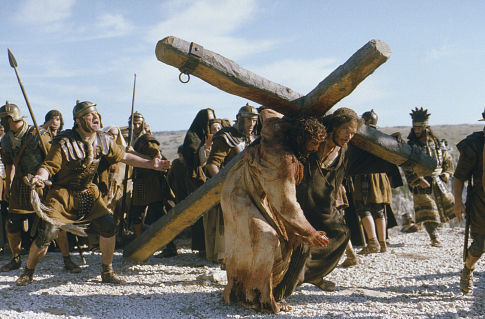|
Reviews of Recent Independent, Foreign, & Documentary Films in Theaters and DVD/Home Video
THE PASSION OF THE CHRIST
The Passion of the Christ is a live-action 21st century version of medieval images of
Christ's suffering. In Western Europe, circa 1400, believers were taught that by piteously
beholding images of the instruments used to torment and kill Jesus, they could earn merit and
better appreciate his sacrifice. Like those images, this film draws the viewer into unbearable pain
and sorrow.
Director and producer Mel Gibson, who embraces a particularly conservative form of
Catholicism, has modeled his depiction of Jesus's last journey on the Stations of the Cross, a
medieval ritual procession evoking the Passion. In the film, Jesus collapses a specific number of
times while carrying the cross. St. Veronica wipes his face with a cloth, which then retains a
miraculous image of Jesus, etched with his blood. These details are not found in the Bible.
Mary (Maia Morgenstern) appears mostly with expressions of wordless horror and pity. For
much of the time the passion is seen through her eyes, consciously evoking the medieval tradition
of Our Lady of Sorrows. The taking down of Christ from the cross ends in a Pietà, a
traditional group tableau. Mary Magdalene (Monica Bellucci) has almost no lines: in a brief
flashback she is identified (according to post-Biblical tradition) as the woman taken in adultery
and saved by Jesus's intervention.
The villains of the piece are the Roman soldiers as much, or even more, than the high priests,
who conspire to do away with a dangerous critic and rival. The soldiers take gleeful, sadistic
pleasure in inflicting even more pain than their orders require.
In one respect, however, this film is a product of our time. We are so used to screen violence that
to shock us sufficiently, blows to the head must echo like thunderclaps and beatings must leave
the body tattered into bleeding ribbons. The scourging of Jesus (reported briefly and
inconsistently in the Gospels) here becomes a prolonged ordeal for cast and audience alike.
Whether one regards the film as overtly or (still worse) deliberately anti-Judaic or anti-Semitic is
to some extent a matter of perspective and sensitivities. Jesus's condemnation takes place in an
atmosphere of conflict between different sections of the people in Judaea. Most (not all) of the
chief priests arouse a rather amorphous crowd to mob hatred against Jesus. The crowd is, of
course, mostly Jewish: this is Jerusalem. But so are the disciples (and Jesus himself); so are a
minority of priests who sympathize with Jesus and denounce the kangaroo court held against
him.
Many commentators argue that the Gospels deliberately lessened Pilate's guilt and exaggerated
that of the Jews for political reasons, connected with the Jewish revolt against Rome in the late
60s C.E. To expect Gibson to have edited or changed the Gospel accounts according to modern
historical criticism may (or may not) be beside the point. Some critics of the Gibson film would
also characterize the Gospels as inaccurate and/or misleading. Pilate (Hristo Naumov Shopov) is
depicted as a weak and nervous bureaucrat, who fears that whatever decision he makes will spark
a riot. That portrayal conforms to the image in the Gospels but, again, not to the views of
historians who have pointed to his proven brutality. In a minor concession, the acceptance of
their guilt by the “whole people” in Matthew 27:25 was absent from the subtitles (and, it seemed,
also the soundtrack) in the version seen by this reviewer.
One valid reason why commentators have reacted against the film is that it gives no coherent
explanation of why Jesus's death was for the good of all humanity: therefore, it represents his
death as merely the result of Jewish priestly hatred and Roman savagery. However, it is quite
possible that this real defect in the film arose from the author's deeply conservative (and
unreflective) Christian assumptions, rather than any conscious choice to offend Jewish
sensitivities.
A fundamental problem with this film remains. What does all this suffering mean? In an age
which has seen so much pointless suffering and death of the innocent, even a death as
excruciating as that of Jesus can only make sense if the reason, and the eternal purpose, of it is
explained. There is no attempt at such explanation in this film. Only those with detailed
knowledge of the Catholic tradition will be able fully to decode The Passion. Only those
with strong stomachs will be able to watch it at all without turning away. Dr. Euan Cameron, Henry Luce III
Professor of Reformation Church History, Union Theological Seminary, also appeared in and was
historical consultant for the documentary Martin Luther (PBS)
|
